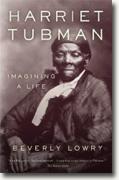Harriet Tubman
Beverly Lowry
book reviews:
· general fiction
· chick lit/romance
· sci-fi/fantasy
· graphic novels
· nonfiction
· audio books
· author interviews
· children's books @
curledupkids.com
· DVD reviews @
curledupdvd.com
newsletter
win books
buy online
links
home
for authors
& publishers
for reviewers

 |
Harriet Tubman: Imagining a Life Beverly Lowry Anchor Paperback 432 pages June 2008 |
|
The skeleton of life of Harriet Tubman is well known. Award-winning author Beverly Lowry has fleshed out the portrait and attempted to separate fable from fact. It is a work of not-quite-fiction that makes a satisfying, adult read.
Minty, still a slave, married a free man named Tubman and took a new first name, Harriet. Since this marriage would not be legitimized in the dominant white culture (meaning that any offspring of Harriet would be slaves), it became more and more imperative that she leave the South. With the aid of Quakers and others along the Underground Railroad, Harriet not only freed herself but, at great risk, went back numerous times to free every member of her family who remained below the Mason-Dixon line. She then became an abolitionist, admonishing President Lincoln to free all slaves. She spoke with simple eloquence, perhaps augmented by the strange visions which came upon her from time to time. After a prescient dream, she met John Brown, who referred to her upon first seeing her as "General Tubman." As Lowry states, "The psychic bond was formed." Her body forever scarred by slavery's abuses, Harriet was as tough as a man and fierce. She went to South Carolina once the Civil War broke out and not only nursed the Union soldiers but assisted in the orientation of newly freed slaves. Her forays into the forests and brush to save enclaves of terrified blacks, and her speech-making up North, earned her the title Moses. She was determined to see her people freed. Very likely, it was as simple as that. There were only a handful of black men preaching the abolitionist doctrine, and a larger number of white men who, free themselves, sought liberty for others. There were brave white women who met and plotted and risked their lives in the service of the Underground Railroad and the larger cause of putting an end to slavery. But Harriet Tubman was unique in her service to her people. She took on man's work from childhood and did not shrink from bloody battle or from the responsibilities of the podium in her zeal to end slavery. Lowry's book is written in present tense, which this reviewer finds rather tedious. Because it is a work of "imagination", the reader will not be sure exactly what portions are real and which are fabricated. However, the fabrications are based on reasonable speculation, so even though the book is peppered with perhapses and might haves, one accepts that the author's intention was to create tone and color to connect history's frail sheaf of documents and put life into the old story. Originally published on Curled Up With A Good Book at www.curledup.com. © Barbara Bamberger Scott, 2008 |
|
|
|
 Click here to learn more about this month's sponsor! |
|
| fiction · sf/f · comic books · nonfiction · audio newsletter · free book contest · buy books online review index · links · · authors & publishers reviewers |
|
| site by ELBO Computing Resources, Inc. | |
 Tubman was born Araminta Ross, daughter of a slave woman on a small plantation in the Chesapeake Bay area of Maryland. It has been documented that the child Minty, as she was called, was sent out to work in the homes of neighbors who treated her with extreme brutality from the age of six. Her first job was child-minding, and her female boss whipped her several times a day when she did not perform her round-the-clock duties satisfactorily. Having "failed" at the job, she was set to doing man's work in a lumberyard. At some point, a white man threw a heavy weight in her direction, aimed at another slave, and Minty received a traumatic head wound which left her with seizures, headaches and visions. Her religious convictions ran deep; when her owner was recalcitrant about freeing her, though it had been a stipulation of his father's will, she began to pray for his soul, and when it seemed that the prayers had no effect, she prayed he would die. He was dead within a week.
Tubman was born Araminta Ross, daughter of a slave woman on a small plantation in the Chesapeake Bay area of Maryland. It has been documented that the child Minty, as she was called, was sent out to work in the homes of neighbors who treated her with extreme brutality from the age of six. Her first job was child-minding, and her female boss whipped her several times a day when she did not perform her round-the-clock duties satisfactorily. Having "failed" at the job, she was set to doing man's work in a lumberyard. At some point, a white man threw a heavy weight in her direction, aimed at another slave, and Minty received a traumatic head wound which left her with seizures, headaches and visions. Her religious convictions ran deep; when her owner was recalcitrant about freeing her, though it had been a stipulation of his father's will, she began to pray for his soul, and when it seemed that the prayers had no effect, she prayed he would die. He was dead within a week.